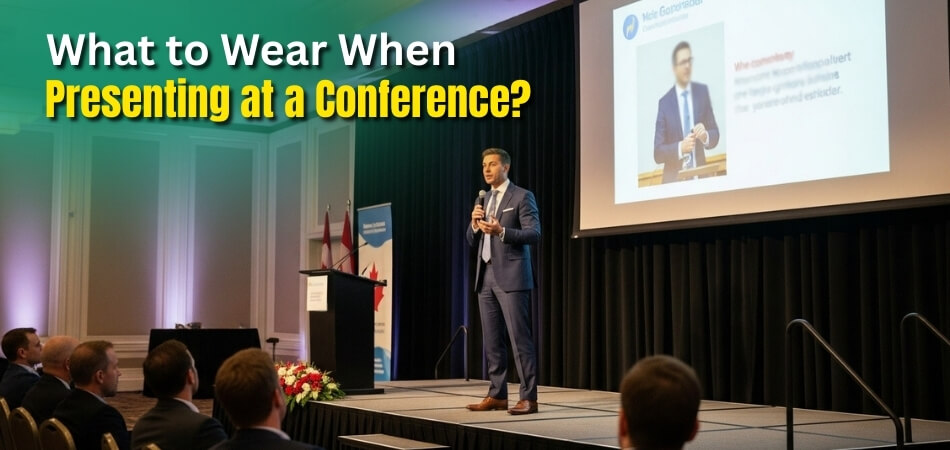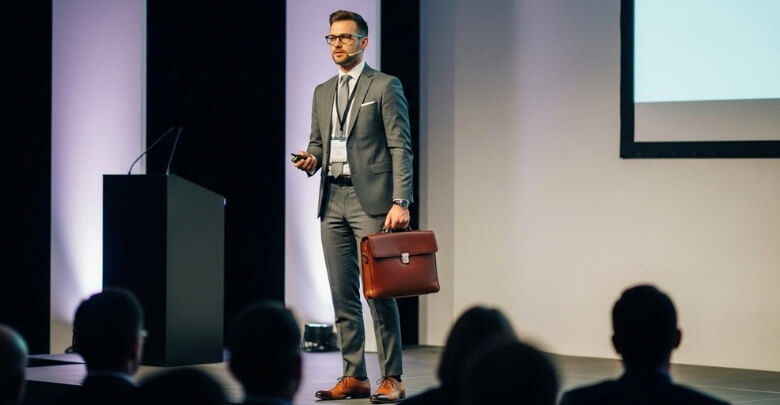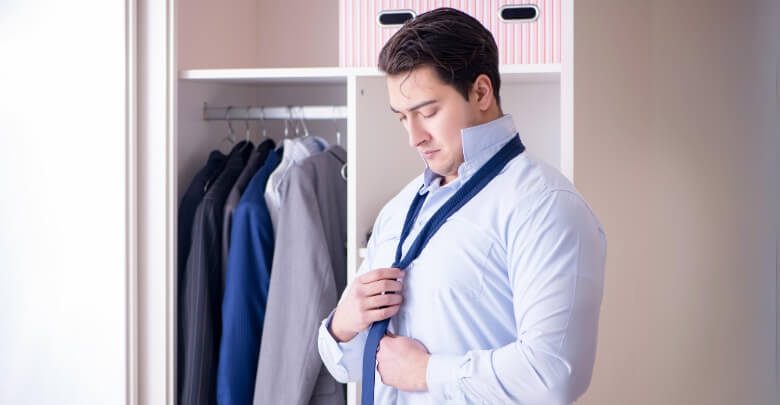First impressions matter a lot, especially when you’re standing in front of a crowd at a conference. How you dress can quietly shape how people listen to you, even before you say a word. That’s why many people start thinking early about what to wear when presenting at a conference.
The best outfit for a conference presentation should be neat, comfortable, and appropriate for the event. Formal suits or blazers fit high-level events, while smart casual is better for relaxed settings. Your clothing must reflect the tone without being too flashy. Neutral shades, simple accessories, and proper grooming complete the look and help you appear professional and confident.
Curious to know more about how to pick the perfect outfit for any type of conference? Or want to feel confident, look professional, and avoid outfit mistakes on stage? Then keep reading this article, which covers everything you need to know about dressing right for your next presentation.
What to Wear When Presenting at a Conference?
Standing in front of people at a conference means your appearance matters just as much as your words. The right clothes can give you confidence and make your message stronger. Let’s look at some simple tips to choose wisely.

Dress Code Basics
Before anything else, check if the event has a dress code. Some conferences ask for formal wear, while others are more relaxed. If no dress code is mentioned, smart casual is usually a safe choice. Dressing in line with the event shows respect and professionalism, especially when you are thinking about the dress code for presentation sessions.
Formal Clothing
A suit or blazer with a neat shirt is a classic option for formal events. For men, pairing it with a tie can make the look sharper. Women can go for blazers, dresses, or well-fitted tops with trousers or skirts. Choosing the right formal attire for presentation means sticking to simple colors that don’t distract the audience.
Smart Casual
If the event is less formal, smart casual works well. Men can wear collared shirts with trousers or chinos, while women can choose blouses, skirts, or dress pants. For activities like presenting posters at the conference, this style keeps you professional but also comfortable. Avoid very flashy prints or logos. Comfort and neatness matter more than being too stylish.
Comfortable Footwear
Standing for a long time during presentations can be tiring, so your shoes should be comfortable. Closed-toe shoes like loafers, flats, or low heels are safe picks. Avoid sneakers unless the conference is casual or creative in nature. Good shoes help you feel steady and confident.
Neat Accessories
Accessories should be simple and not distracting. A watch, a pair of small earrings, or a neat belt are fine choices. Avoid heavy jewelry or noisy items that may pull attention away from your talk. Keep it minimal and professional.
Grooming and Cleanliness
Neatly combed hair, clean nails, and fresh breath matter as much as your clothes. Wrinkled shirts or messy hair can make you look unprepared. A well-groomed appearance shows that you take the presentation seriously. Small details create a big difference in how people see you.
Why Your Outfit Matters During a Presentation?
When speaking in front of an audience, the way you dress can influence how people listen to you. Clothes not only show respect but also affect how confident you feel on stage. Choosing the right outfit makes a big difference. Let’s understand why your outfit really matters.
First Impressions
Your audience notices your conference presentation outfit before you even start talking. A neat and proper outfit creates a positive first impression. It tells people that you respect the event and the audience. A careless look, on the other hand, can make them take you less seriously.
Building Confidence
Wearing the right clothes gives you a sense of confidence. When you feel comfortable in your outfit, you focus more on your words and ideas. If your outfit is uncomfortable or distracting, it can make you nervous. A confident look helps you speak more clearly.
Showing Professionalism
A well-chosen presentation attire shows that you take the presentation seriously. It reflects professionalism and effort. Even if the topic is casual, dressing neatly shows that you value the time of those listening. It also helps the audience trust what you are saying.
Avoiding Distractions
Bright colors, heavy accessories, or very casual clothes can pull attention away from your words. When the audience is busy looking at your outfit, they may miss the key points of your talk. Choosing simple and balanced clothing helps everyone stay focused on your message.
Respecting the Event
Different events have different levels of formality. Dressing according to the event shows that you understand and respect the setting. For example, if you are preparing for upcoming conferences, choosing the right outfit helps you match the tone of the event. A conference may need formal wear, while a small workshop may allow something more casual. Matching your outfit to the event keeps things appropriate.
Boosting Connection
Your outfit can also help you connect with the audience. Looking approachable and neat makes people more comfortable listening to you. If you dress too casually or too formally for the occasion, it may create a gap. The right choice helps you look friendly and confident.
Business Formal vs Business Casual: Which One Do Presenters Prefer Most?
Getting ready for a presentation often raises the question of whether business formal or business casual is the better choice. Both styles have their own strengths and are chosen depending on the event and audience. Let’s compare them side by side for a better idea.
|
Aspect |
Business Formal |
Business Casual |
|
Appearance |
Gives a polished and professional look that feels serious and respectful. |
Looks neat and relaxed while still showing professionalism. |
|
Comfort |
Can sometimes feel tight or less comfortable for long hours. |
Usually, it is more comfortable and easier to move in during presentations. |
|
First Impression |
Leaves a strong impact and shows high respect for the audience. |
Creates a friendly and approachable vibe that feels more relaxed. |
|
Event Suitability |
Best for large conferences, high-level meetings, or official events. |
Works well for smaller gatherings, workshops, or casual conferences. |
|
Confidence Boost |
Formal outfits may give presenters a sense of power and authority. |
Casual wear may help presenters feel more at ease and natural. |
|
Flexibility |
Offers fewer choices, usually limited to suits, ties, and formal dresses. |
Allows more variety with shirts, blouses, trousers, and smart skirts. |
|
Audience Reaction |
Audience may view the presenter as highly serious and authoritative. |
Audience may feel more connected and comfortable with the relaxed approach. |
|
Maintenance |
Needs careful ironing, dry cleaning, and extra attention to details. |
Easier to maintain, a simple wash and press often works well. |
Do the Venues Influence What You Wear?
Yes, the venue does influence what you wear. The place where you present sets the tone for how formal or casual your outfit should be. A suitable outfit makes you look prepared and confident. Look below to know how venues influence what you wear.
Formal Venues
Big halls, hotels, or professional conference centers usually call for formal outfits. A suit, blazer, or dress shows respect for the serious nature of the place. Dressing too casually in such venues may look unprofessional. A polished outfit matches the formal setting.
Casual Venues
Smaller venues like community centers or open classrooms allow a more relaxed look. Smart casual clothing, such as shirts, trousers, or neat blouses, works well. You don’t need to overdress for these places, but neatness is still important. Casual venues let you keep it simple yet professional.
Outdoor Settings
When the presentation is outdoors, comfort should be a top priority. Light and breathable clothing works best, especially in warm weather. Shoes should also be practical since you may need to move around more. Outdoor settings allow you to mix style with comfort.
Large Stages
If you are on a large stage, your outfit should help you stand out. Bold but neat colors and structured clothing look clear even from a distance. Avoid dull shades that may make you blend into the background. Large stages need clothes that highlight your presence.
Small Rooms
In smaller rooms, you will be closer to the audience. Dressing neatly but in a more approachable style works best. Very formal outfits may feel too stiff in such settings. Choose clothing that balances professionalism and comfort for direct interaction.
Key Accessories That Complete the Look of the Presenter
Clothing alone is not enough to create a strong presence during a presentation. The right accessories can add style, balance, and confidence without taking away attention from your words. Let’s explore some simple accessories that make a real difference.
Classic Watch
A watch is a timeless accessory that adds elegance to your look. It shows that you value time and helps you keep track during your talk. Avoid flashy designs that may distract the audience. A simple, neat watch works best for a professional setting.
Subtle Jewelry
Jewelry can enhance your style, but it should remain minimal. Small earrings, a light chain, or a plain ring add charm without pulling focus. Avoid heavy or noisy pieces that may become a distraction. The goal is to look polished, not overdone.
Professional Belt
A clean belt ties your outfit together and gives a neat finish. Choose a simple design in black or brown, matching your shoes for a balanced look. Avoid large buckles or bright colors that may look unprofessional. A good belt adds both function and style.
Neat Bag
Carrying a smart bag or briefcase helps you stay organized. It gives a professional image and keeps your notes, laptop, or other essentials safe. A bag that looks tidy shows preparation and care. Avoid oversized or messy-looking bags for presentations.
Quality Shoes
Shoes are often noticed more than people realize. Polished shoes complete your outfit and add confidence to your walk. Avoid worn-out or dirty shoes, as they can spoil your overall appearance. Comfortable yet stylish shoes help you move confidently on stage.
Simple Glasses
If you wear glasses, choose frames that suit your face and look neat. Avoid oversized or overly stylish ones that may distract from your words. Glasses can actually add to your smart and professional appearance. Keep them clean for the best impression.
Light Scarf or Tie
A tie or scarf adds a finishing touch to your outfit. They can bring a pop of color while still keeping things professional. Avoid very bold patterns or bright shades that steal attention. A well-chosen tie or scarf shows detail and care.
Tips on Matching Your Outfit to Your Audience and Topic
Not every audience reacts the same way to how you dress. The topic you are presenting also has an influence on what outfit works best. Picking the right style can help your message connect better. Let’s look at some tips for adjusting your outfit choices.
Corporate Audience
People in a corporate setting usually expect formal clothing. Suits, blazers, and professional dresses work best to match their environment. Going too casual may make you appear less serious about your topic. A formal style creates trust and shows that you respect their standards.
Academic Audience
When presenting to an academic group, neat and simple outfits are best. A collared shirt with trousers or a modest dress can strike the right balance. They often value content more than appearance, but a clean look still matters. Dressing modestly helps your audience focus on the knowledge you are sharing.
Casual Audience
In a casual setting, you can relax your clothing style without looking unprepared. Polo shirts, neat blouses, or smart casual outfits are usually enough. Very formal clothing may make you look too distant. Choosing a relaxed yet tidy look helps you connect easily with the audience.
Tech-Focused Audience
Tech audiences usually prefer a modern but comfortable style. Smart casual works well, such as shirts, jeans, or clean sneakers. Wearing overly formal clothing may feel out of place in this crowd. Keeping the look professional but practical matches the fast and creative environment.
Matching the Topic
Your outfit should also reflect the subject you are presenting. A serious business report feels right with formal wear, while creative or relaxed topics allow more flexibility. For example, a presentation about design can carry a stylish, casual outfit. When the outfit fits the theme, your words feel stronger.
Balancing Details
Small details like ties, scarves, or jewelry can adjust your look depending on the audience. A touch of color works well for friendly settings, while plain and simple choices suit formal topics. Overdoing accessories can distract from your speech. Finding balance keeps the focus on you and your content.
Planning Smartly
When preparing your overall presentation, along with outfit planning, you should also consider things to add in conference presentation that match the audience’s expectations. A clear plan helps you feel confident and professional. Outfits and presentation details together create a lasting impression. Dressing thoughtfully makes your talk both effective and memorable.
Commonly Asked Questions
Every presenter wonders what outfit will help them look confident, professional, and approachable. Questions about style, comfort, and setting often come up before a big event. Below are some common questions with clear answers to guide you.
Should You Avoid Bright Colors in Presentations?
Bright colors can easily draw attention away from your words. If you wear neon shades or loud patterns, the audience may focus on your outfit instead of your message. Neutral, calm colors like navy, gray, or beige work much better. These tones help keep the attention on what you are saying instead of what you are wearing.
Is It Okay to Wear Traditional Clothes at a Conference?
Yes, traditional clothing is acceptable if it fits the event’s tone. Many conferences welcome cultural attire, as long as it is neat and respectful. Traditional outfits can even make you stand out positively when worn properly. The key is making sure it looks tidy and professional.
How Important Is Fabric Choice?
Fabric affects comfort and neatness. Wrinkle-free materials like blended cotton or polyester help you stay sharp throughout the day. Fabrics that crease easily may look messy after sitting or moving. Breathable fabrics are also great when you expect long hours under bright lights.
How Should You Handle Wrinkled Clothes?
Wrinkled clothing gives the impression that you are unprepared. Always iron or steam your outfit before the event. Packing wrinkle-free clothes or carrying a small travel steamer helps when traveling. A crisp, neat look shows professionalism without you saying a word.
What If You Are Presenting Online?
Even in virtual settings, clothing still matters. Wearing neat and solid-colored outfits looks better on camera. Avoid stripes or loud patterns, as they may not appear clear on screens. Looking professional online helps your audience take your words seriously.
Should You Always Wear a Blazer?
Blazers add instant formality, but they are not always necessary. In casual or relaxed events, a well-ironed shirt can be enough. If you want a polished touch, a blazer works perfectly. The choice depends on the event’s level of seriousness.
How Do You Dress if Unsure About the Event Type?
If you’re not sure, it’s better to be slightly more formal than too casual. A blazer or neat shirt usually fits both cases. Carrying an extra accessory like a tie or scarf can adjust your look quickly. Safe choices help avoid looking out of place.
Conclusion
Looking your best while presenting isn’t about being trendy. It’s about showing that you’re prepared, confident, and respectful of your audience. A thoughtful outfit can help you feel calm and stay focused when all eyes are on you.
Whether it’s a large formal conference or a casual local meet-up, your clothing should match the vibe of the event and your topic. Think about comfort, setting, and the people you’ll be speaking to. Small details like your shoes or accessories can also play a big part.
Now that you’ve got a clear idea of what to wear when presenting at a conference, take a little time to plan your outfit just like you plan your speech. When your appearance matches your message, you’re already halfway to a great presentation.







